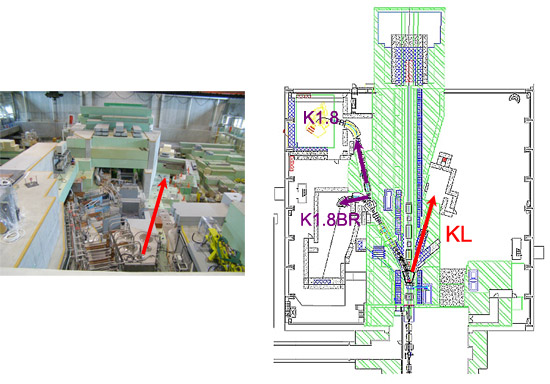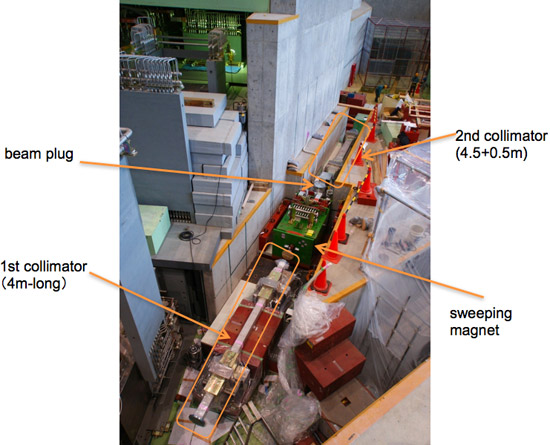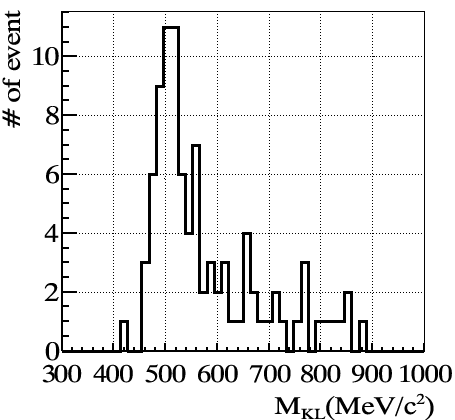| |
Confirmation of neutral kaons in the KL beam line at Hadron Hall, J-PARC
|
J-PARC Center
|
TOKAI-MURA, IBARAKI -
The collaboration of Experiment E14,
led by Professor Taku Yamanaka of Osaka University
and abbreviated as KOTO*1,
has successfully confirmed neutral kaons
in the KL beam line at the Hadron Hall of J-PARC.
Following the completion of the K1.8BR beam line,
the construction of the K1.8 beam line (downstream of K1.8BR)
and the KL beam line
as well as
the installation and tuning of the experimental apparatus continued
in the hall (Figure 1).
The K1.8BR and K1.8 beam lines,
located in the north part of the hall, are for the experiments
with charged kaons and π mesons.
On the other hand,
the KL beam line (Figure 2) is located in the south part
and transports
only the neutral particles, produced in the target by the proton beam,
after sweeping charged particles away using a magnet.
The experimentalists of the KOTO collaboration
designed and constructed the new beam line
to generate a neutral beam with small diameter (called "pencil beam")
by using two stages of the metal collimator,
and started to make a survey of the beam quality
in the J-PARC operation of this autumn.
Since neutral kaons cannot be measured directly with usual methods,
they detected secondary particles: charged π mesons and photons
from a kaon decay,
reconstructed their primary particle,
and calculated the mass.
After analyzing the data collected in short beam hours in November,
they successfully observed the peak at the neutral-kaon mass (500MeV/c2)
in the reconstructed mass distribution (Figure 3),
which is consistent with the distribution
predicted by computer-simulation studies.
The KOTO collaboration will continue the survey
to improve the statistical precision of the measurement
and to obtain the yield and momentum spectrum
of the neutral kaons in the KL beam line.
This confirmation of neutral-kaon production,
following the confirmation of the charged-kaon production
in the K1.8BR beam line in April,
demonstrates that the experimental study of
the particle and nuclear physics
at Hadron Hall continues to make great strides.
For the KOTO collaboration,
this is a big step forward to discover rare neutral-kaon decay
by using the high-intensity beam from J-PARC.
|
| |
| *1: | J-PARC E14 KOTO Experiment (experimental study of rare neutral-kaon decay)
This is the experiment to investigate the new origin of the broken symmetry
between particles and anti-particles (CP violation)
by measuring the extremely-rare decay mode of
the neutral K meson (kaon)
by using the high-intensity beam from J-PARC.
It aims at the discovery of the decay process
of a long-lived neutral kaon (KL)
into a neutral π meson and a pair of neutrinos,
which is predicted in the Standard Model of particle physics
to occur with a rate of once in forty billion.
"KOTO" is the abbreviated name for "K0 at TOkai".
33 experimental physicists from the institutes in Japan
(KEK, Osaka University, Kyoto University, Saga University,
Yamagata University, and NDA)
and 29 from abroad (USA, Taiwan, Korea, Russia)
participate in the KOTO experiment (Figure 4). |
 |
Figure 1 : Hadron Hall to be ready
for the J-PARC operation in autumn 2009 (left)
and its plan view (right).
The KL beam line is located in the south part
(to the right) of the hall and is extracted at an angle of 16 degrees. |
 |
Figure 2 : KL beam line, whose apparatus consists of
two stages of the metal collimator in the upstream and downstream,
a magnet, and a plug to interrupt the beam.
They are covered by radiation-shielding blocks
and cannot be visited. |
 |
Figure 3 : Reconstructed mass distribution of
the KL -> π+π-π0 decay events. |
 |
Figure 4 : KOTO-collaboration logo (left) and the group photo in this summer (right). |
|

